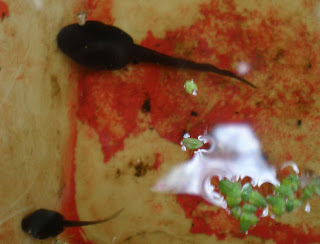In 2006 Year 6 students, with teachers and parents, set about building an eco pond and the rest followed. Now, in 2008 we have a habitat rich with reptiles, invertebrates and, at last, frogs!


After the initial structure was created the task was to transform black plastic, concrete and sandstone into a place that frogs would choose to live. It was said that any body of water left for 6 weeks would attract frogs but we found that was not the case.
Much research went into finding species of native plants that grow in the local area and would encourage frogs to move in. With advice from some plant enthusiasts in the Wolli and Bardwell Valleys we recieved both advice and donated plants including:
River Club Rush Schoenoplectus validus (sourced from Botany wetlands);
Knobbly Club Rush Isolepis nodosus;
Tall Sedge Carex appressa - local to the Cooks River Valley;
Blady Grass Imperata cylindica (sourced locally);
Kidney weed Dichondra repens;
An aquatic fern called Azolla was introduced to help clean up the water and Duckweed mysteriously appeared (possibly arriving in small quantities with one of the donated plants). Lomandra, dianella and bracken ferns were sourced from Marrickville Community Nursery and the result is a pond that looks like this:

Frogs were first noticed on a weeding and watering expedition during the summer holidays. A frog loudly and proudly sang "bonk.... bonk..." to our delighted ears. After school returned, tadpoles could be seen flicking about under the Azolla and duckweed and one enterprising kindergartener lifted a section of pond to find a fully grown frog underneath. This camouflaged fellow is a Striped Marsh Frog.

The tadpoles were observed in two distinct sizes. The large ones with slightly-developed back legs and the small ones without. This suggests that perhaps several adults have bred at different stages and the prospect looks good for an ongoing population at the school.


Some weeks later front legs became apparent.


Then, at last, we found a fully developed frog:

We have yet to stock the pond with fish. That's one creature that will not be able to find its own way to the ELA! Extensive research was undertaken to identify a local native fish species that would control mosquito larvae without eating frogs eggs or tadpoles. These will be sourced locally as fish from aquariums may not be acclimatised to Sydney outdoors! In the meatime, there's plenty of exciting life to be studied in and around the eco pond.

Frog update
At Gardening Club (12 March 2009) our Yr 1 naturalist, Trystan (pictured above) found not just frog spawn, well concealed under the Carex grass, but also the frog who appeared to be in the process of laying the eggs.


Activity - research and draw the life cycle of a frog.
Activity - answer this online frog quiz.